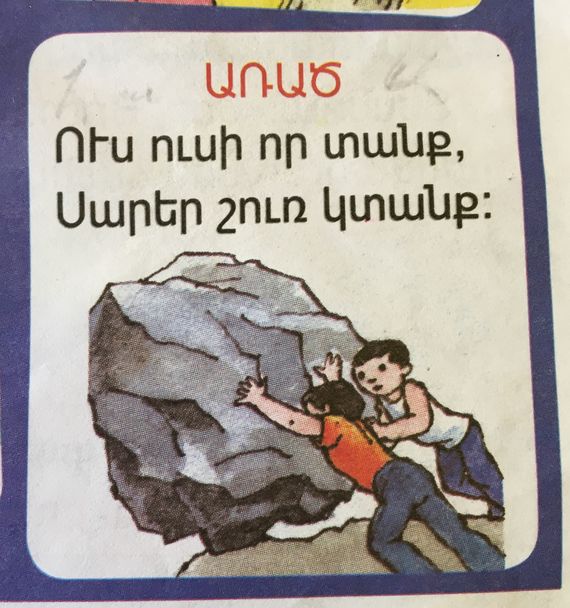



Gender Stereotyping
It’s very important to realize that boys must be brave, risky, and girls – feminine and gentle.[2]
Not only are girls and women underrepresented in textbooks, they are also portrayed in stereotypical roles, both in text and illustrations. The conventional gender expectations regarding people’s careers, household roles, duties, physical looks and behaviors apply to both male and female characters.
Boys are portrayed as strong individuals doing athletic activities or carrying out tasks that require muscular strength. One might argue that illustrations only serve as complementary materials to the stories and must be created accordingly. However, in texts where the sex of the characters isn’t even mentioned, gender stereotypes still apply to the accompanying illustration.
The text in image 1 reads, “A proverb: If we bring our shoulders together, we will move mountains.” Note that the text is completely gender neutral, yet the illustrator and authors of the book have ascribed the the quality of being strong to boys only. This kind of bias and stereotyping isn’t unique to one textbook only or to Armenia specifically but seems almost universal. It is even more apparent when it comes to occupations and household duties, e.g. girls do the shopping, washing, cooking, ironing while boys repair and carry things.






The textbooks for crafts (home economics)[3] even goes a step further by blatantly dividing activities into “for girls” and “for boys” sections. For instance, the sixth grade[4] crafts textbook has ten units: four for boys, four for girls and two joint ones. According to the visual indicators next to the unit titles, girls are supposed to engage in cooking, sewing and knitting, while boys are presented with woodwork, metal processing and various machines. The only lessons that are co-educational are graphics and electronics.
To conclude, textbooks don’t present women in their full professional capacities. The range of available career choices presented for women is limited and often passive. By not portraying women as decision-makers, scientists and entrepreneurs, textbooks directly or indirectly shape students’ career choices, likely creating constraints between their aspirations and established norms.
By failing to properly highlight female freedom fighters, social workers, artists, writers and politicians, by failing to include Armenian female writers’ and artists’ work in public school textbooks, the authors and publishers of these textbooks devalue the role of Armenian women and their legacy in our collective history. By leaving out women like Mariam Khatisyan, Mari Beylerian, Zabel Yesayan and many more, they artificially suppress inspiration for achievement among half the younger generation and the entire Armenian nation unfortunately suffers as a result.

